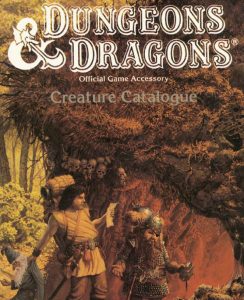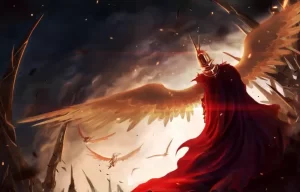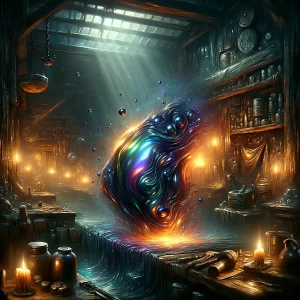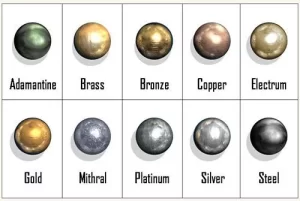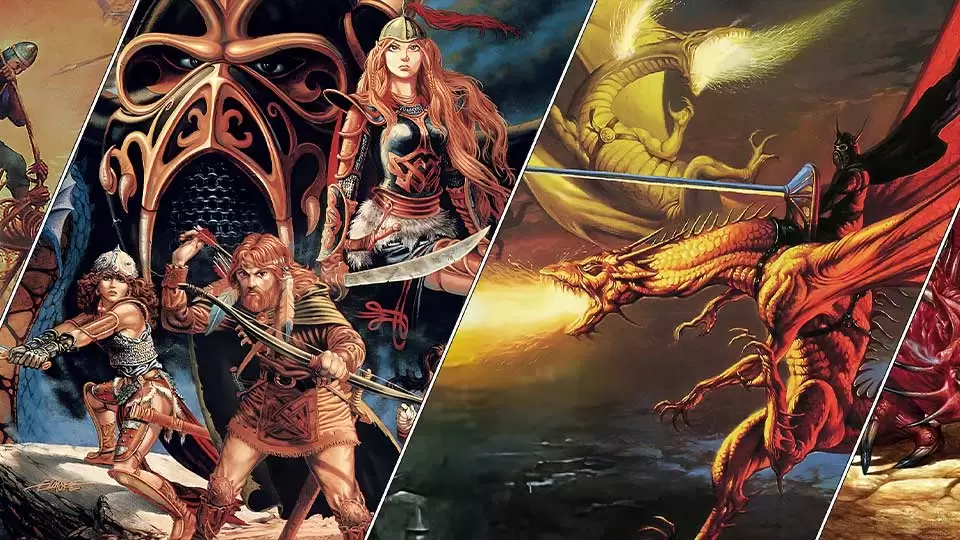
In the many places of fantasy worlds that comprise the multiverse of Dungeons & Dragons, few settings resonate with as much emotion and depth as Dragonlance. Birthed in the 1980s from the collaborative minds of Tracy Hickman and Margaret Weis, Dragonlance is more than just a campaign setting. It's a sprawling narrative, a meditation on heroism, and a testament to the power of stories to shape our very perceptions of good, evil, and everything in between.
Origins of a Legendary Tale
Dragonlance began as the brainchild of Tracy Hickman and his wife Laura before Tracy's tenure at TSR, Inc. Upon joining the iconic company behind D&D, Tracy partnered with novelist Margaret Weis, merging gaming and literature in an unprecedented fashion. Their collaborative magic led to the publication of Dragons of Autumn Twilight and the groundbreaking D&D module DL1: Dragons of Despair, marking the inception of a narrative that would redefine role-playing storytelling.
The Enigmatic World of Krynn
At the very core of Dragonlance lies Krynn, a richly detailed world steeped in wonder and conflict. Its main continent, Ansalon, offers diverse settings from the frostbitten wilderness of Icewall Glacier to the scorching sands of Khur. Populated by a vibrant beings - such as the regal Silvanesti elves, passionate Qualinesti, steadfast dwarves of Thorbardin, and irrepressibly curious kender - Krynn pulses with life and stories waiting to unfold.
Magic on Krynn isn't merely mystical; it's cosmically entwined with three lunar gods: Solinari, Lunitari, and Nuitari, patrons of Good, Neutral, and Evil magic respectively. The waxing and waning of Krynn's moons directly influences magical power, making spellcasting as poetic as it is tactical.
Solinari (Good magic)
Lunitari (Neutral magic)
Nuitari (Evil magic)
Magic's potency changes according to the lunar phases - a unique Dragonlance trait.
Chronicles of Destiny
Dragonlance uniquely intertwines its novels and gaming modules. Central to its narrative legacy are the Dragonlance Chronicles, a trilogy chronicling the Heroes of the Lance - Tanis Half-Elven, Laurana, Flint Fireforge, Sturm Brightblade, and the enigmatic mage Raistlin Majere. These heroes' struggles against Takhisis, the dark goddess seeking dominance over Krynn, capture the profound emotional complexity that defines Dragonlance storytelling.
Following the Chronicles, the Dragonlance Legends trilogy takes readers deeper into the haunting duality of Caramon and Raistlin Majere, exploring themes of ambition and redemption against a backdrop of time travel and magical intrigue.
The Dragonlance Pantheon: A Trinity of Balance
The setting's mythology revolves around a unique trinity of divine forces. Paladine symbolizes Good's unwavering virtue, Gilean epitomizes the impartiality of Neutrality, and Takhisis embodies dark ambition and conquest. Dragons themselves, embodying these divine influences, become both heroes and harbingers of doom. Powerful relics known as Dragon Orbs further amplify the mystical grandeur, allowing mortals to influence these mighty creatures.
Crisis, Resurgence, and Transformation
Though Dragonlance experienced fluctuations in popularity - particularly during transitions in the ownership and editions of D&D - its narrative resilience is evident. The War of Souls series notably revitalized the setting, depicting a world abandoned by its gods, challenging characters to navigate existential uncertainty as new powers emerged.
Throughout these shifts, Dragonlance retained a fiercely loyal community, sustained by fan devotion and the continued expansion of its lore through novels and fan creations.
The Lasting Legacy
Dragonlance reshaped the landscape of fantasy gaming by demonstrating how deep narrative and complex characters enhance player engagement. Figures like Tanis Half-Elven, the tormented Raistlin Majere, and the courageous Laurana Kanan set new standards for character depth, influencing generations of players and writers.
Tales Beyond the Core
Beyond the core sagas, Krynn brims with stories waiting to be discovered. Characters like Kitiara Uth Matar, known as the Blue Lady, blur the lines between hero and villain, providing rich insights into ambition and morality. Series such as The Meetings Sextet and The Preludes illuminate the formative pasts of beloved characters, expanding the emotional stakes of their later adventures.
The Intrigue of Ansalon
The socio-political intricacies of Krynn are reminiscent of real-world history. Noble houses in cosmopolitan cities like Palanthas, particularly the influential di Caelas and uth Matar families, engage in shadowy intrigue. Port Balifor and the notorious pirates of the Blood Sea showcase how commerce and power struggles shape the continent's history and fuel endless storytelling opportunities.
Creatures Beyond the Ordinary
Krynn innovatively expands traditional fantasy tropes. Draconians, born from corrupted dragon eggs, blend tragic origins with fierce prowess, exemplifying Dragonlance's capacity for nuanced characterization. Similarly, the Irda, elegant and magically gifted beings descended from ogres, explore themes of fall and redemption seldom seen elsewhere.
Echoes of Lost Empires
Ancient mysteries permeate Krynn, such as the submerged ruins of Istar, a lost city whose pride led to catastrophic downfall during the Cataclysm - an event that reshaped continents and forever changed history. Mystical locales like Godshome, a sacred site where mortals commune with deities, and the enigmatic Pillar of the Moons, offer profound adventure hooks and lore.
Krynn and Its Wonders
At the heart of Dragonlance lies the world of Krynn. It's a realm where gods walk amongst mortals, where ancient dragons soar the skies, and where heroes are forged amidst adversity:
Ansalon: The main continent where most of Dragonlance's tales unfold. It's a land of diverse climates, from the icy reaches of Icewall to the desert expanses of the Khur.
Races and Cultures: Beyond humans, Ansalon is home to the Silvanesti and Qualinesti elves, the mountain and hill dwarves, kender (a race unique to Dragonlance), and many more. Each race brings many cultures, histories, and aspirations to Krynn's narrative.
Chronicles of Heroism
Few D&D settings have narratives as interwoven with the game's modules as Dragonlance:
The Dragonlance Chronicles: Comprising three novels, this series introduces readers and players to the Heroes of the Lance. Their quest to thwart the evil goddess Takhisis and her draconian armies forms the setting's core narrative.
The Dragonlance Legends: This trilogy delves deeper into the lives of key characters, focusing on the twins Caramon and Raistlin Majere, and their journey through time and magic.
Dragons, Magic, and the Pantheon
Krynn stands apart in its treatment of dragons, magic, and deities:
Dragons: Central to the setting, these majestic creatures are agents of the gods, playing roles as both saviors and destroyers. The Dragon Orbs, powerful artifacts, can control them.
Magic: Magic in Krynn is channeled through three Moon Gods, with its potency waxing and waning with their phases. The Orders of High Sorcery, based in their iconic Towers, govern the use of arcane arts.
Gods: The pantheon is a trinity of balance. The gods of Good (like Paladine), Neutral (Gilean), and Evil (Takhisis) exist in equilibrium, shaping the world's destiny through their followers.
Crisis and Renaissance
Over the years, Dragonlance has witnessed both immense popularity and periods of stagnation. However, the setting's beauty lies in its rebirths:
War of Souls: A series that marked a renaissance for Dragonlance, delving into a Krynn where gods had vanished, and new powers arose.
Post-TSR Era: Despite a lack of mainstream support in D&D's later editions, Dragonlance continued to thrive through novels and a dedicated fanbase.
Legacy and Impact
Dragonlance's influence on fantasy and role-playing is profound:
Character Depth: The setting introduced a level of character depth rarely seen before. Heroes like Raistlin, Tanis, and Laurana are celebrated for their complex personalities and struggles.
Narrative Integration: Dragonlance blurred the lines between novels and gaming, showing that rich narratives could enhance tabletop experiences.
To dive into Dragonlance is to embark on an odyssey of emotion, valor, and introspection. It's not just about mighty dragons or epic quests, but the intimate moments between friends, the internal battles within a mage's heart, and the ever-present dance between light and shadow. As the moons of Krynn move through their celestial dance and as dragons soar its skies, one truth remains clear: Dragonlance is a testament to the enduring power of stories and the worlds they can conjure.
This deep dive into Dragonlance captures its essence, but like any grand tale, there's always more to discover, always another layer to peel back. In the annals of fantasy role-playing, Dragonlance stands tall, not just as a setting or a series, but as an adventure that has touched souls across generations.
Tales Beyond the Main Arc
While the Chronicles and Legends are perhaps the most iconic narratives of Dragonlance, Krynn's rich world extends far beyond these tales:
Heroes and Anti-Heroes: Dragonlance has introduced a plethora of characters outside the central group. The tales of the likes of Kitiara Uth Matar, the Blue Lady and former lover to Tanis, offer a unique perspective on the boundaries between passion, ambition, and malevolence.
Side Stories: Series such as The Meetings Sextet delve into the backstories of the Heroes of the Lance, illuminating past events that shaped their futures. The Preludes and Preludes II offer similar deep dives, providing context and depth to familiar tales.
The Socio-Political Landscape of Ansalon
Krynn isn't just a backdrop for epic adventures; it's a dynamic world with its own intricate geopolitics:
Noble Houses and Power Struggles: In cities like Palanthas, powerful families like the di Caelas and the uth Matar hold sway, their ambitions and machinations echoing the dance of politics familiar in our own histories.
Mercantile Guilds and Pirates: The trading city of Port Balifor and the bloodthirsty pirates of the Blood Sea remind us that in Krynn, as in any world, economics and power are inextricably linked.
Beyond Dragons: Creatures of Krynn
The world is inhabited by more than just dragons and standard fantasy races:
Draconians: Birthed from the corrupted eggs of goodly dragons by dark sorcery, these unique dragon-humanoids serve as a testament to the setting's flair for reinventing classic fantasy tropes.
Irda: These high ogres, with their beautiful forms and potent magic, are far removed from the brutish ogres most are familiar with. Their story is one of grace, fall, and the potential for redemption.
Lost Civilizations and Mysteries
The ancient history of Krynn is rife with lost empires and enigmatic ruins:
The Lost City of Istar: Once a beacon of light and the seat of the Kingpriest, its hubris led to the Cataclysm, an event that reshaped the very continents. Today, its ruins lie submerged, a haunting testament to the perils of unchecked power.
Mystical Sites: Places like Godshome, where mortals can purportedly converse with deities, and the Pillar of the Moons in Nightlund, offer unique adventure hooks for Dungeon Masters and tantalizing lore for readers.
Artistic and Cultural Contributions
Beyond the books and modules, Dragonlance has inspired a wealth of associated media:
Artwork: The evocative illustrations by artists such as Larry Elmore and Clyde Caldwell have played an indelible role in shaping the visual identity of Dragonlance.
Adaptations: From graphic novels to a 2008 animated movie, Dragonlance's narratives have been reimagined across various media, bringing its tales to new audiences.
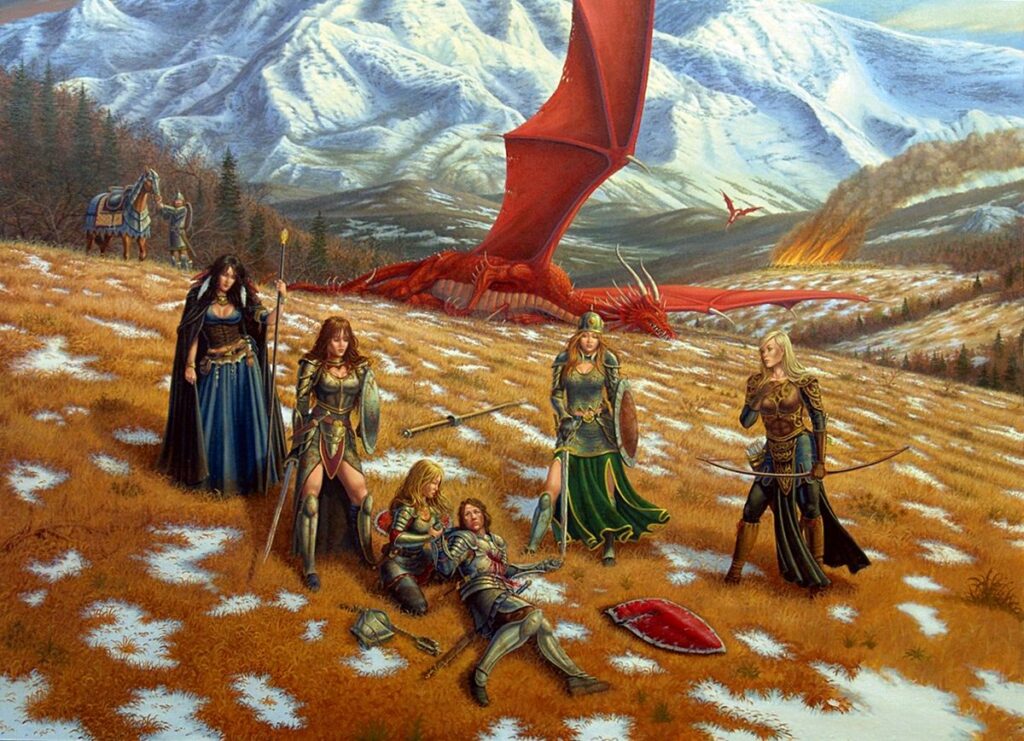
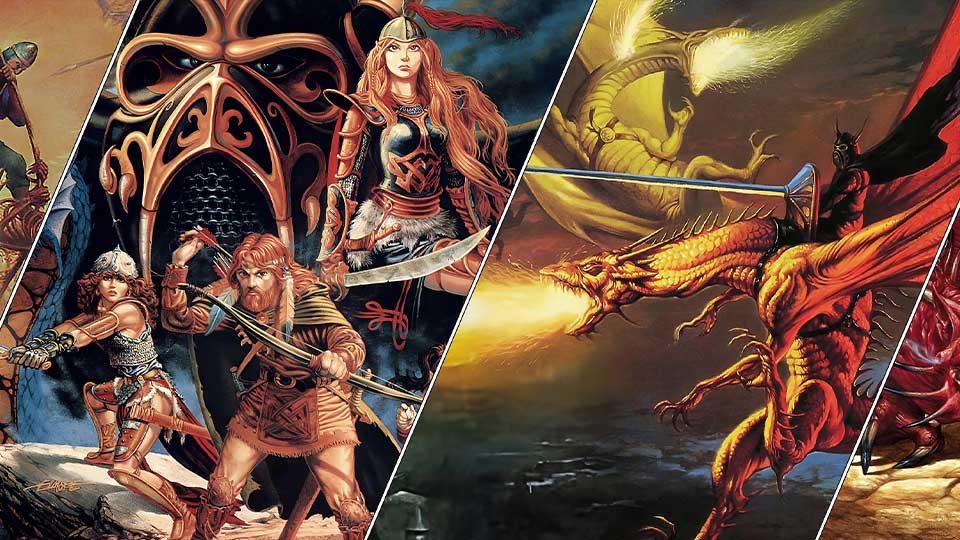

Reflections
As we delve deeper into Dragonlance, it becomes evident that its allure lies not just in its epic tales of heroism but in its nuanced exploration of themes like redemption, the duality of nature, and the consequences of ambition. Through its characters, its lore, and its world-building, Dragonlance offers a multifaceted mirror, reflecting both the fantastical and the achingly human. In Krynn, we find a realm of dreams, dragons, and drama, but also a world that, at its heart, is a poignant study of the human condition.
With this expansion, our exploration of Dragonlance delves even further into the elements that make it a beloved and enduring cornerstone of fantasy role-playing.

